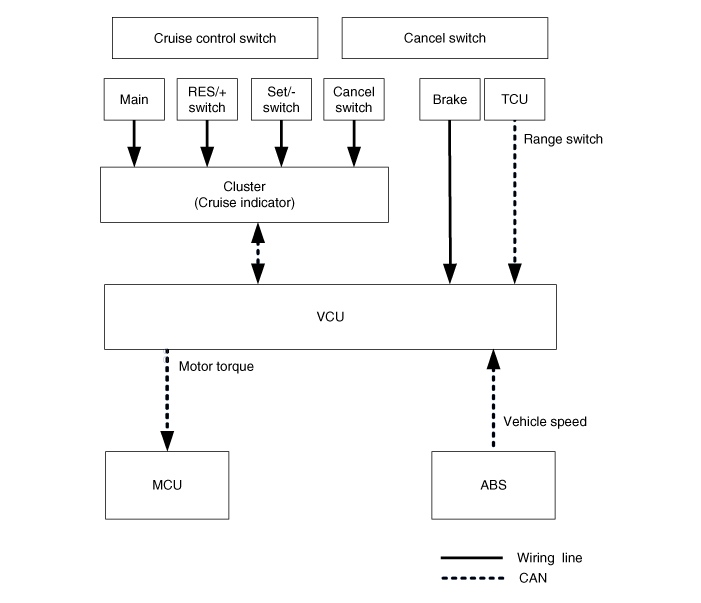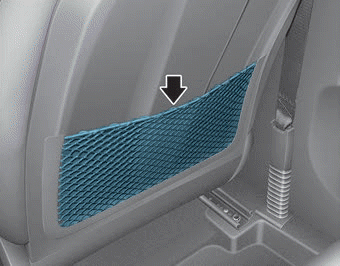Hyundai Ioniq: Cruise Control System / Schematic diagrams
Hyundai Ioniq (AE) 2017-2025 Service Manual / Advanced Driver Assistance System (ADAS) / Cruise Control System / Schematic diagrams
| System Block Diagram |

Component Parts and Function Outline
|
Component part
|
Function
| |
| Vehicle-speed sensor, ESP/ABS Control Module | Converts vehicle speed to pulse. | |
| VCU | Receives signals from sensor and control switches. | |
| Cruise control indicator | Illuminates when CRUISE main switch is ON (Built into cluster) | |
| Cruise Control switches | CRUISE switch | Switch for automatic speed control power supply. |
| Resume/Accel switch (RES +) | Controls automatic speed control functions by Resume/Accel switch (Set/Coast switch) | |
| Set/Coast switch (RES -) | ||
| Cancel switches | Cancel switch | Sends cancel signals to VCU. |
| Brake-pedal switch | ||
| Transaxle range switch (A/T) | ||
| ETC Motor | Regulates the throttle valve to the set opening by ECM. | |
* ETC Motor : Electronic Throttle Control Motor
 Description and operation
Description and operation
Cruise ControlThe cruise control system is engaged by the cruise "ON/OFF" main switch located on right of steering wheel column. The system has the capability to cruise, coast, accelerate and resume speed...
 Troubleshooting
Troubleshooting
Trouble Symptom ChartsTrouble Symptom 1Trouble Symptom 2
Trouble symptom
Probable cause
Remedy
The set vehicle speed varies greatly upward or downward"Surging" (repeated alternating acceleration and deceleration) occurs after settingMalfunction of the vehicle speed sensor circuitRepair the vehicle speed sensor system, or replace the partMalfunction of ECMCheck input and output signals at ECMTrouble Symptom 3
Trouble symptom
Probable cause
Remedy
The CC system is not canceled when the brake pedal is depressedDamaged or disconnected wiring of the brake pedal switchRepair the harness or replace the brake pedal switchMalfunction of the ECM signalsCheck input and output signals at ECMTrouble Symptom 4
Trouble symptom
Probable cause
Remedy
The CC system is not canceled when the shift lever is moved to the "N" position (It is canceled, however, when the brake pedal is depressed)Damaged or disconnected wiring of inhibitor switch input circuitRepair the harness or repair or replace the inhibitor switchImproper adjustment of inhibitor switchMalfunction of the ECM signalsCheck input and output signals at ECMTrouble Symptom 5
Trouble symptom
Probable cause
Remedy
Cannot decelerate (coast) by using the "SET/–" switchTemporary damaged or disconnected wiring of "SET/–" switch input circuitRepair the harness or replace the "SET/–" switchMalfunction of the ECM signalsCheck input and output signals at ECMTrouble Symptom 6
Trouble symptom
Probable cause
Remedy
Cannot accelerate or resume speed by using the "RES/+" switchDamaged or disconnected wiring, short circuit or "RES/+" switch input circuitRepair the harness or replace the "RES/+" switchMalfunction of the ECM signalsCheck input and output signals at ECMTrouble Symptom 7
Trouble symptom
Probable cause
Remedy
CC system can be set while driving at a vehicle speed of less than 40km/h (25mph), or there is no automatic cancellation at that speedMalfunction of the vehicle-speed sensor circuitRepair the vehicle speed sensor system, or replace the partMalfunction of the ECM signalsCheck input and output signals at ECMTrouble Symptom 8
Trouble symptom
Probable cause
Remedy
The cruise main switch indicator lamp does not illuminate (But CC system is normal)Damaged or disconnected bulb of cruise main switch indicator lampRepair the harness or replace the part...
Other information:
Hyundai Ioniq (AE) 2017-2025 Service Manual: Quarter Garnish. Repair procedures
Replacement • Put on gloves to prevent hand injuries. • When removing with a flat-tip screwdriver or remover, wrap protective tape around the tools to prevent damage to components...
Hyundai Ioniq (AE) 2017-2025 Service Manual: AVN(Audio Video Navigation) head unit. Components and components location
C..
Categories
- Manuals Home
- 1st Generation Ioniq Owners Manual
- 1st Generation Ioniq Service Manual
- Washer Fluid
- Auto Door Lock/Unlock Features
- Folding the side view mirrors
- New on site
- Most important about car
Seatback pocket

The seatback pocket is provided on the back of the front passenger's seatback.
WARNING
To prevent the Occupant Classification System from malfunctioning:
Copyright © 2025 www.hioniqae.com
